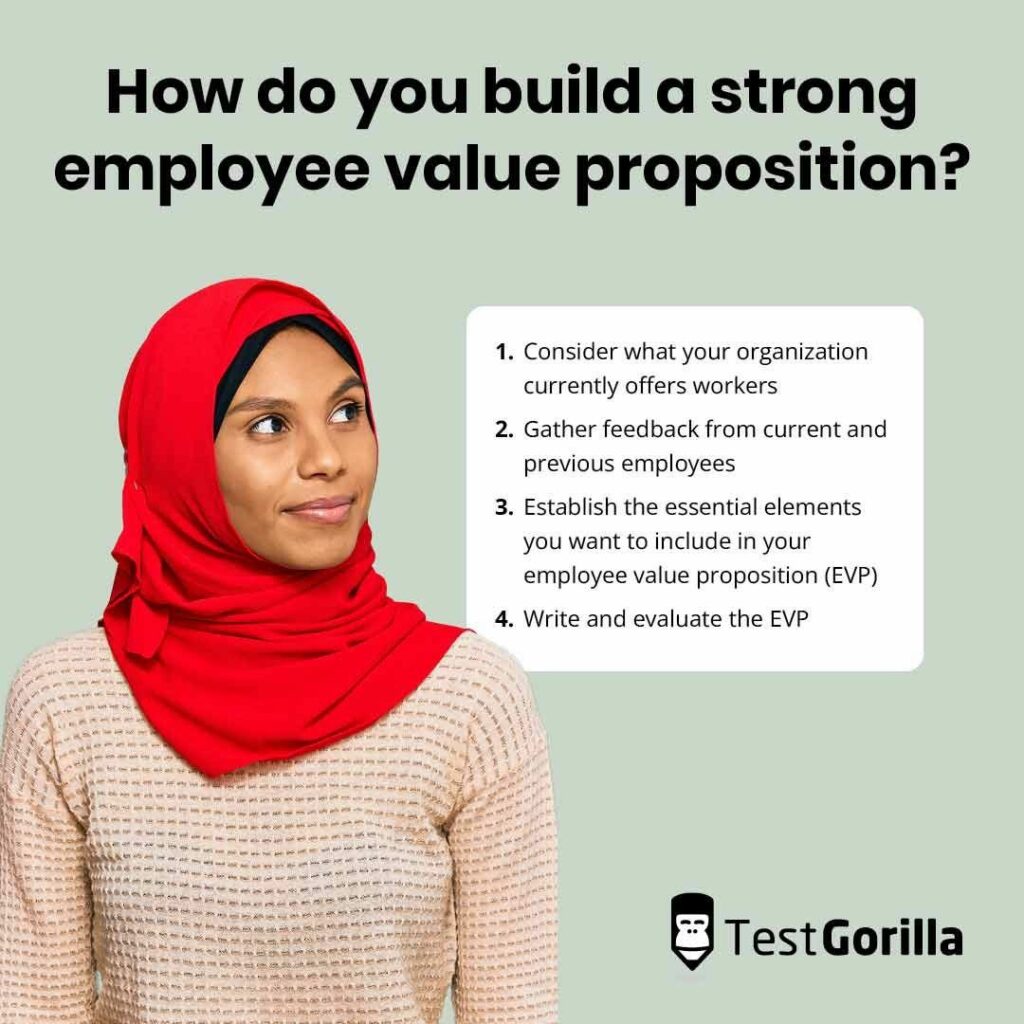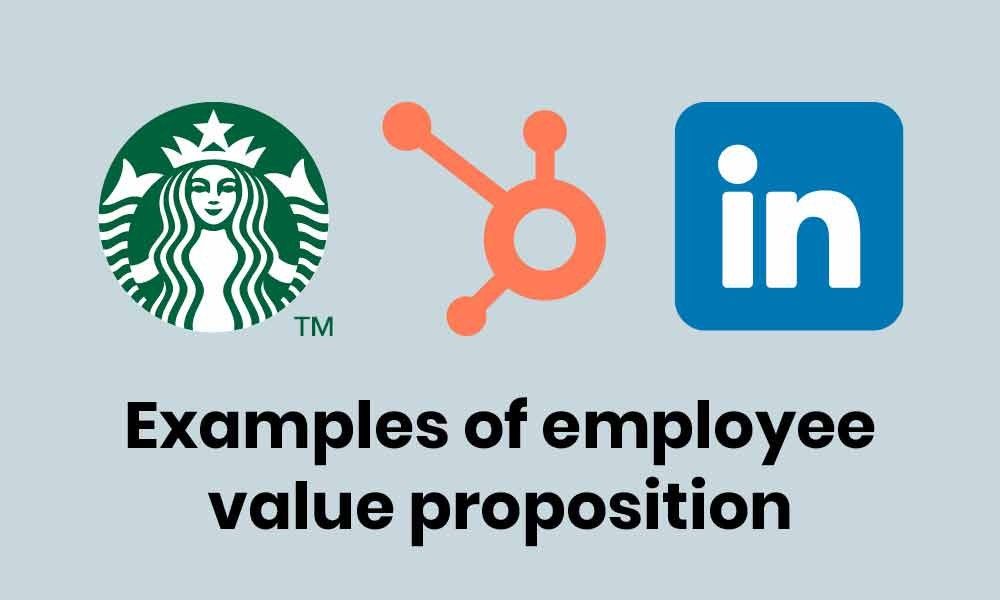What’s the best way to incentivize productivity and promote your brand simultaneously? Is it compensation? A good work-life balance? Upskilling employees with skills assessment tests? All of these factors are crucial.
As an HR professional, you may already know that these are some of the key parts of an employee value proposition. But what other factors should yours include, and where can you find inspiration when creating a top employee value proposition?
Read on to find out about three inspiring examples of brands that aced their employee value proposition and how to create your own.
Table of contents
What does EVP mean in HR?
In the context of HR, EVP stands for employee value proposition, a commitment you make to your employees in exchange for their continued effort and loyalty. A simpler employee value proposition definition is that it includes all the rewards and core benefits your employees get from your organization.
An EVP can be part of your employer branding strategy and should include a few crucial elements.
What makes a great employee value proposition?
The following are some of the rewards and benefits you can offer your employees as part of an EVP:
Good compensation
Good compensation is one of the cornerstones of a great EVP. In addition to employees’ salaries, this part of your EVP can include bonuses and other perks.
Compensation might not be equally important to all employees. For instance, millennial professionals seek benefits that help make their lives easier. However, the compensation you offer as part of your EVP should be fair and performance-based.
Work-life balance, including paid time off
Research shows that more than two-thirds of workers consider work-life balance to be the most important aspect of their job, which is why it should be a critical part of your EVP.
You can help your employees maintain a healthy work-life balance by offering them vacation time, flextime, paid time off, retirement plans, remote work opportunities, and paid parental leave.
Not every work-life value proposition will meet every employee’s preferences, so customizing these benefits is important.
Career stability
The factors that make up this essential part of an EVP include career development, training, and coaching. In short, learning and development are critical for your EVP.
Career stability can involve upskilling workers based on benchmarked skills. Using skills tests is an excellent way to offer suitable, tailored training sessions based on your employees’ abilities.
For example, if you want to help a technical SEO professional advance in their career, develop training sessions that address their skills gaps as indicated by the results of a Technical SEO test.
Current resources and technology
If you have remote employees, consider offering them current technology to facilitate their work. It’s not uncommon for tech companies to give their remote workers laptops and other technology so that they can complete projects from home.
How do you build a strong EVP?
You can build an exceptional EVP by following the simple steps described below.
1. Consider what your organization currently offers workers
What does your company currently offer its employees?
It’s important to consider this to determine what’s missing from your EVP. Perhaps your remuneration package is exceptional, but you don’t offer a good work-life balance. You can then work on a list of the elements missing from your EVP.
2. Gather feedback from current and previous employees
Gathering employee feedback can give you a more objective view as you build your EVP. Find out your employees’ opinions by distributing surveys and conducting exit interviews, and learn what your employees think is missing from your business.
Make sure you ask suitable questions to dig deeper into their opinions, such as the following:
“What factors motivate you to engage at work?”
“Are there any improvements we can make as a business?”
“How can we better support you to achieve your career goals?”
3. Establish the essential elements you want to include in your EVP
After considering all the feedback, it’s time to look for trends in the information you’ve gathered from your employees. Do you notice any patterns in the feedback? Which factors will appeal to your top talent and potential candidates?
When establishing the EVP’s essential elements, remember that each candidate or employee will want different things.
Recent graduates may be looking for career opportunities, whereas applicants with many years of experience may want remote work opportunities. Carefully consider the feedback you’ve collected to choose what you’ll offer in your EVP.
4. Write and evaluate the employee value proposition
When drafting your EVP, you’ll need to reconcile two main concerns: What can your business realistically offer employees, and what are your candidates’ needs? Your EVP should bridge the gap between what candidates want and what your organization can provide.
Write your EVP succinctly and review it objectively by comparing it with those offered by your competitors. When you’ve finished writing your EVP, get feedback from employees and adjust it accordingly.
What is an example of an employee value proposition?
There are plenty of top EVPs you may wish to emulate. Here are three inspiring examples of brands that got their EVP right.
Starbucks
Starbucks promises its candidates the option to join the company and become “partners in shared success.” Its EVP includes training and development opportunities for its partners, providing them with “limitless opportunities to make an impact and thrive.”
The company offers health coverage, such as medical, vision, and dental plans, paid time off for retail and non-retail partners, parental leave, a Family Expansion Reimbursement of $10,000 for each adoption or surrogacy, and more.
HubSpot
HubSpot knows that “benefits and perks matter” and contribute to a remarkable employee experience. The software company provides its employees with exceptional rewards to enhance their work-life balance.
One of its core beliefs is that “work and life should fit together.”
The company practices what it preaches by offering remote work opportunities, a sabbatical after five years with the business, unlimited vacation options, mental health resources and therapy sessions, leadership training, tuition reimbursement, and plenty of other elements to make working for the company a unique and special experience.
The benefits LinkedIn offers are known as InLife benefits and perks, which aim to make the lives of the career platform’s employees “even better.”
Many critical factors feature in LinkedIn’s EVP, including:
Must-haves like paid time off and life insurance
Extras such as fitness classes, personal trainers, and student loan repayment assistance
Health-related perks like a comprehensive wellness program
Charitable perks
Options such as paid parental leave
Together, these benefits contribute to a remarkable EVP to keep team members content and engaged.
What to remember when creating an employee value proposition
An EVP is fundamental for engaging your employees and giving them something to look forward to. When you create one, remember to ask your employees what matters to them and which factors they think your organization can improve on.
Remember that a fundamental part of your EVP is career progression opportunities, so check out TestGorilla’s test library to facilitate upskilling and training your employees. You can sign up for a free account today and start creating your EVP the right way to motivate and inspire your employees.
Related posts
Hire the best candidates with TestGorilla
Create pre-employment assessments in minutes to screen candidates, save time, and hire the best talent.
Latest posts
The best advice in pre-employment testing, in your inbox.
No spam. Unsubscribe at any time.

Hire the best. No bias. No stress.
Our screening tests identify the best candidates and make your hiring decisions faster, easier, and bias-free.
Free resources
This checklist covers key features you should look for when choosing a skills testing platform
This resource will help you develop an onboarding checklist for new hires.
How to assess your candidates' attention to detail.
Learn how to get human resources certified through HRCI or SHRM.
Learn how you can improve the level of talent at your company.
Learn how CapitalT reduced hiring bias with online skills assessments.
Learn how to make the resume process more efficient and more effective.
Improve your hiring strategy with these 7 critical recruitment metrics.
Learn how Sukhi decreased time spent reviewing resumes by 83%!
Hire more efficiently with these hacks that 99% of recruiters aren't using.
Make a business case for diversity and inclusion initiatives with this data.






















